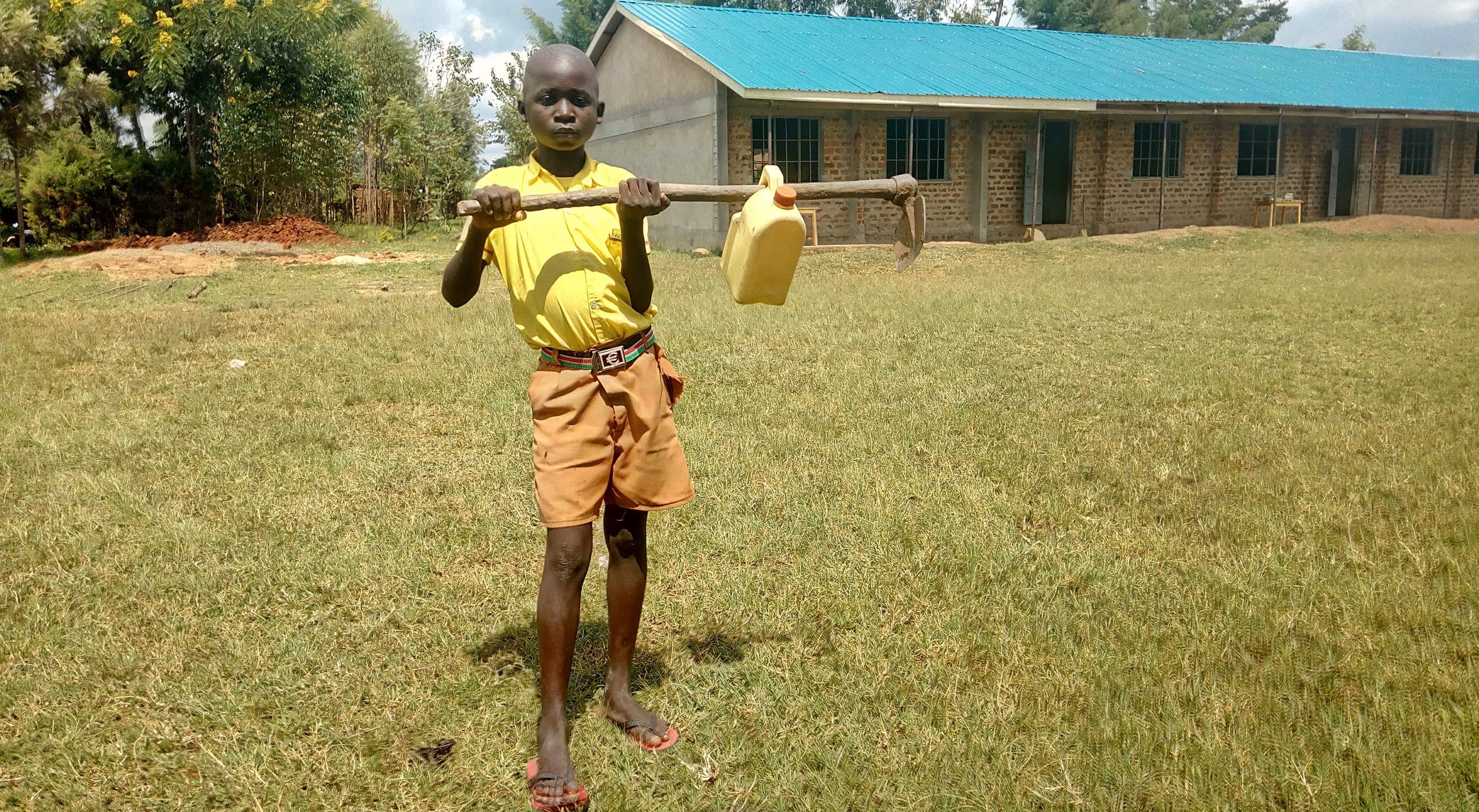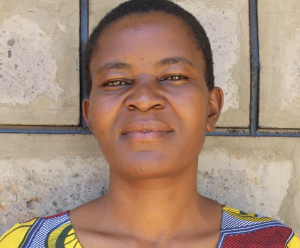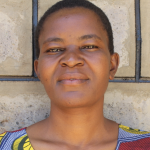November, 2019: St. Margret Wadin'go Primary School Project Complete!
St. Margret Wadin'go Primary School in Kenya now has access to a new source of safe, clean water thanks to the completion of their rain tank, which has the ability to collect 50,000 liters of water. We installed new latrines for students, handwashing stations, and we trained students and staff on improved sanitation and hygiene practices. All of these components work together to unlock the opportunity for these students to live better, healthier lives.

Students pose with the new rain tank
Rain Tank
Construction for this 50,000-liter rain tank was successful!
Parents, staff, and students helped our artisans gather everything needed for construction. All the while, the school cooks prepared meals for the artisans, and the school provided accommodations for the artisans during their work. Local women and men helped our artisans with their manual labor, too.

Students carry bricks to the construction site at school
The process officially began with our staff and school administration looking around the school compound to try and determine the best location for a new rain tank. This needed to be the best site with good, clean roofing to catch the rainwater.
Then, we cleared the site: excavating the soil within the required measurements to make level ground for the tank foundation. The foundation was cast by laying hardcore on level ground and then reinforcing it using steel, concrete and waterproof cement.

Rain tank under construction surrounded by building materials
Both the drawing pipe as well as the washout pipe were affixed as the foundation was laid. The wall was built with ferro-cement techniques through 6 layers. The inner wall was plastered while rough casting was done on the outer part. Finally, the catchment area was dug, plastered, and a staircase installed.
Dome construction could begin after the superstructure had been given enough time to settle. The manhole cover was fitted, inlet pipes were connected to the roof gutters, inlet screens, ventilation pipes (breathers) and overflow pipes were all done to standard.

Cementing interior of tank walls and support pillar
Once finished, the tank was given 3 to 4 weeks to undergo complete curing before it was cleaned and handed over to St. Margret Wadin'go Primary School, though we will continue to offer them unmatchable support as a part of our monitoring and maintenance program.
The celebration was a great chance for us to acknowledge the school administration and students as the primary parties entrusted with the tools we’ve given, as well as remind them of our continued support as they develop.

Girls posing with the new rain tank
"The project has really made the face of the school change compared to other years when pupils would be seen wasting a lot of time queuing [at] the toilets with no privacy for boys and girls. This brought shame, mostly on girls. Those pupils who could not administer the situation would go around the bush near the school," said Head Teacher Mr. Wawire.
"But we thank God who has provided at the right time when we were really in need...We were at risk because we used to drink water from different homes [and] this made pupils and teachers [get] sick every now and then. But [now] we are free from diseases and other risks. When I see the structure of the tank, my heart is overwhelmed and I know more is yet to come. Thank you so much."

Getting a drink from the rain tank
The school's security officer, Mr. John Were Wasike was also very pleased with the project and expressed his pride to us on the day of the celebration as he posed with the tank for a picture, getting a drink.
"We are glad and so happy because the face of this school has really changed. Being a small school, the Lord chose us [out of] many schools and you people came and rescued us. It is not in vain. May God reward you. I know the number of pupils will increase rapidly," Mr. Wasike said.

School Security Officer Mr. John Were Wasike
VIP Latrines
This project funded the installation of 6 new ventilated improved pit (VIP) latrines, half for girls and half for boys. All of these new latrines have cement floors that are designed to be easy to use and clean. And with a rain tank right on school property, there should be enough water to keep them clean.

Students in front of their new latrines
Handwashing Stations
The 2 handwashing stations were delivered to the school and handed over to the student health club. These were placed outside of the girls’ and boys’ latrines to encourage handwashing after latrine use.

Thumbs up for clean hands! Posing with the handwashing stations
Health club members teach other students how to properly wash their hands at the stations, make sure the stations are filled with water, and work to ensure that there is always soap or ash available.
New Knowledge
Hygiene and sanitation training was scheduled with the help of the school principal and Deputy Head Teacher Mr. Jacob Sifuna, who together ensured that the training date would be convenient for students, staff, and parent representatives. Individual teachers helped by selecting students from each class to represent the others.
Some 17 students attended the training, which was lower than usual but at the same time expected because the national exams were ongoing at the time, preventing more students from attending. The training was conducted under a tree, which was pleasant in the shade and conducive for learning in the fresh air. The only challenge was that pupils in the lower classes who were not taking exams occasionally disrupting the training by crowding around the group, but they were manageable.
The pupils actively participated and were vibrant in the training. They answered and asked questions where they did not understand something clearly, and they offered to demonstrate during activities like the 10 handwashing steps and toothbrushing.

Students at training
We covered a number of topics, including personal hygiene such as bathing, oral hygiene, and handwashing with soap as a barrier from germs; and operation and maintenance of the new facilities, with each person understanding their role for long-lasting clean water and good health. The new student health club will be greatly involved in project management and will be responsible for encouraging good health and hygiene practices amongst their peers, teachers, and the larger community.
During the Leadership and Governance session, the facilitator asked the participants what they understood by the terms leader and leadership. Many responded by saying a leader is a person who is responsible for other people and leadership is a system of ruling others. They went on naming different leaders like pastors, president, chief, headmaster, and village elder. The pupils also named qualities of a good leader like honesty, kindness, and being hardworking. This topic was interesting as almost every participant was willing to vie for the leadership positions in the student health club when it was time to vote, and whenever they failed they went on to vie for the next position. Their enthusiasm was wonderful to witness.

Group work during training
The student health club said they are going to unite and start agricultural activities like planting vegetables and selling them to their teachers to help raise money for solving any emerging issues. We advised the school management to be engaging with the club often and to help them solve their problems.

Student demonstrates toothbrushing during the dental hygiene session
On the topic of child rights, the facilitator started by asking who is a child and a majority of the students responded correctly that a child is any person who is under the age of 18 years based on the Kenya constitution. They also named child rights they knew like their right to education, and their right to basic human needs like shelter, food, and clothing.
The facilitator was happy for the responses and she told them that there is a difference between rights and freedom. A right is universal, while freedom depends on the constitution of a country. This topic was special in that most of the pupils knew a lot about their rights through the way they were responding to the questions, and they also understood the difference between rights and freedom.

Hooray for a fresh drink!
"I thank [your team] for the project and the [student health club] training because I have learned much on the 10 steps of handwashing and the best way on how we should brush our teeth on [a] daily basis," said 12-year-old pupil Davies.
Thank you for making all of this possible!



 Rainwater Catchment
Rainwater Catchment
 Rehabilitation Project
Rehabilitation Project



































